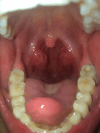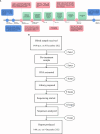Case report: Metagenomics next-generation sequencing in the diagnosis of septic shock due to Fusobacterium necrophorum in a 6-year-old child
- PMID: 38435306
- PMCID: PMC10904578
- DOI: 10.3389/fcimb.2024.1236630
Case report: Metagenomics next-generation sequencing in the diagnosis of septic shock due to Fusobacterium necrophorum in a 6-year-old child
Abstract
Fusobacterium necrophorum (F. necrophorum) infection is rare in pediatrics. In addition, the detection time of F. necrophorum by blood culture is long, and the positive rate is low. Infection with F. necrophorum bacilli usually follows rapid disease progression, resulting in high mortality. In previous reports of F. necrophorum-related cases, the most dangerous moment of the disease occurred after the appearance of Lemierre's syndrome. We report an atypical case of a 6-year-old female patient who developed septic shock within 24 h of admission due to F. necrophorum infection in the absence of Lemierre's syndrome. F. necrophorum was identified in a blood sample by metagenomics next-generation sequencing (mNGS) but not by standard blood culture. The patient was finally cured and discharged after receiving timely and effective targeted anti-infection treatment. In the present case study, it was observed that the heightened virulence and invasiveness of F. necrophorum contribute significantly to its role as a primary pathogen in pediatric septic shock. This can precipitate hemodynamic instability and multiple organ failure, even in the absence of Lemierre's syndrome. The use of mNGS can deeply and rapidly identify infectious pathogens, guide the use of targeted antibiotics, and greatly improve the survival rate of patients.
Keywords: Fusobacterium necrophorum; case report; children; metagenomics next-generation sequencing; sepsis.
Copyright © 2024 Zhang, Liu, Guan, Li, Liu and Ruan.
Conflict of interest statement
Author YG is employed by Hugobiotech Co., Ltd. The remaining authors declare that the research was conducted in the absence of any commercial or financial relationships that could be construed as a potential conflict of interest.
Figures




Similar articles
-
Lemierre's syndrome complicating multiple organ failure caused by Fusobacterium necrophorum subsp. funduliforme F1260: Case report and review.Diagn Microbiol Infect Dis. 2024 Aug;109(4):116375. doi: 10.1016/j.diagmicrobio.2024.116375. Epub 2024 May 23. Diagn Microbiol Infect Dis. 2024. PMID: 38796934 Review.
-
Invasive infections with Fusobacterium necrophorum including Lemierre's syndrome: an 8-year Swedish nationwide retrospective study.Clin Microbiol Infect. 2020 Aug;26(8):1089.e7-1089.e12. doi: 10.1016/j.cmi.2019.12.002. Epub 2019 Dec 14. Clin Microbiol Infect. 2020. PMID: 31843654
-
The long shadow of lemierre's syndrome.J Infect. 2017 Jun;74 Suppl 1:S47-S53. doi: 10.1016/S0163-4453(17)30191-3. J Infect. 2017. PMID: 28646962 Review.
-
Lemierre's syndrome due to Fusobacterium necrophorum.Lancet Infect Dis. 2012 Oct;12(10):808-15. doi: 10.1016/S1473-3099(12)70089-0. Epub 2012 May 25. Lancet Infect Dis. 2012. PMID: 22633566 Review.
-
[Pneumonia caused by Fusobacterium necrophorum: is Lemierre syndrome still current?].Mikrobiyol Bul. 2011 Oct;45(4):729-34. Mikrobiyol Bul. 2011. PMID: 22090304 Turkish.
References
Publication types
MeSH terms
Substances
LinkOut - more resources
Full Text Sources

